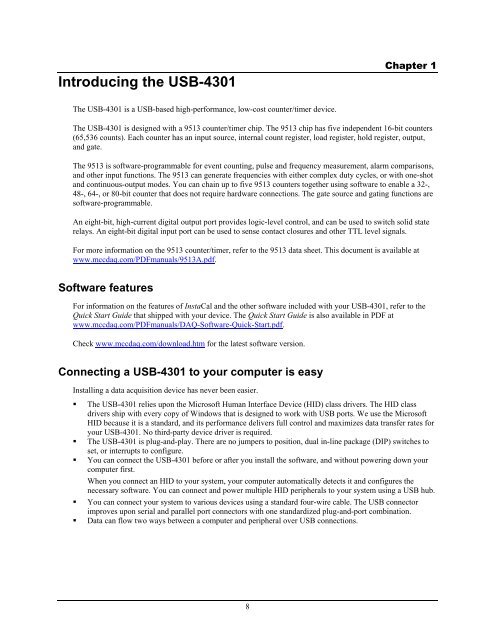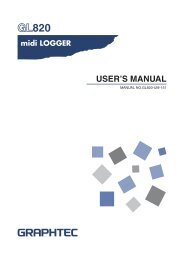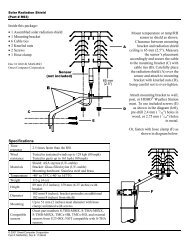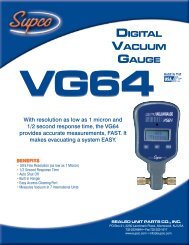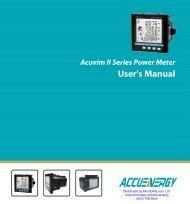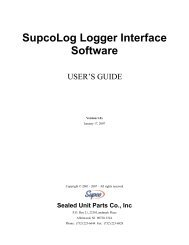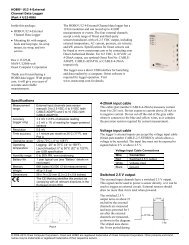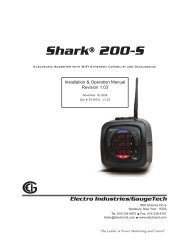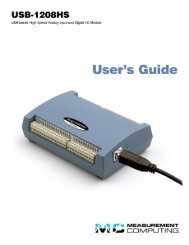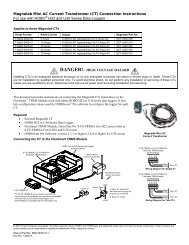USB-4301 User's Guide
USB-4301 User's Guide
USB-4301 User's Guide
Create successful ePaper yourself
Turn your PDF publications into a flip-book with our unique Google optimized e-Paper software.
Introducing the <strong>USB</strong>-<strong>4301</strong><br />
Chapter 1<br />
The <strong>USB</strong>-<strong>4301</strong> is a <strong>USB</strong>-based high-performance, low-cost counter/timer device.<br />
The <strong>USB</strong>-<strong>4301</strong> is designed with a 9513 counter/timer chip. The 9513 chip has five independent 16-bit counters<br />
(65,536 counts). Each counter has an input source, internal count register, load register, hold register, output,<br />
and gate.<br />
The 9513 is software-programmable for event counting, pulse and frequency measurement, alarm comparisons,<br />
and other input functions. The 9513 can generate frequencies with either complex duty cycles, or with one-shot<br />
and continuous-output modes. You can chain up to five 9513 counters together using software to enable a 32-,<br />
48-, 64-, or 80-bit counter that does not require hardware connections. The gate source and gating functions are<br />
software-programmable.<br />
An eight-bit, high-current digital output port provides logic-level control, and can be used to switch solid state<br />
relays. An eight-bit digital input port can be used to sense contact closures and other TTL level signals.<br />
For more information on the 9513 counter/timer, refer to the 9513 data sheet. This document is available at<br />
www.mccdaq.com/PDFmanuals/9513A.pdf.<br />
Software features<br />
For information on the features of InstaCal and the other software included with your <strong>USB</strong>-<strong>4301</strong>, refer to the<br />
Quick Start <strong>Guide</strong> that shipped with your device. The Quick Start <strong>Guide</strong> is also available in PDF at<br />
www.mccdaq.com/PDFmanuals/DAQ-Software-Quick-Start.pdf.<br />
Check www.mccdaq.com/download.htm for the latest software version.<br />
Connecting a <strong>USB</strong>-<strong>4301</strong> to your computer is easy<br />
Installing a data acquisition device has never been easier.<br />
• The <strong>USB</strong>-<strong>4301</strong> relies upon the Microsoft Human Interface Device (HID) class drivers. The HID class<br />
drivers ship with every copy of Windows that is designed to work with <strong>USB</strong> ports. We use the Microsoft<br />
HID because it is a standard, and its performance delivers full control and maximizes data transfer rates for<br />
your <strong>USB</strong>-<strong>4301</strong>. No third-party device driver is required.<br />
• The <strong>USB</strong>-<strong>4301</strong> is plug-and-play. There are no jumpers to position, dual in-line package (DIP) switches to<br />
set, or interrupts to configure.<br />
• You can connect the <strong>USB</strong>-<strong>4301</strong> before or after you install the software, and without powering down your<br />
computer first.<br />
When you connect an HID to your system, your computer automatically detects it and configures the<br />
necessary software. You can connect and power multiple HID peripherals to your system using a <strong>USB</strong> hub.<br />
• You can connect your system to various devices using a standard four-wire cable. The <strong>USB</strong> connector<br />
improves upon serial and parallel port connectors with one standardized plug-and-port combination.<br />
• Data can flow two ways between a computer and peripheral over <strong>USB</strong> connections.<br />
8


